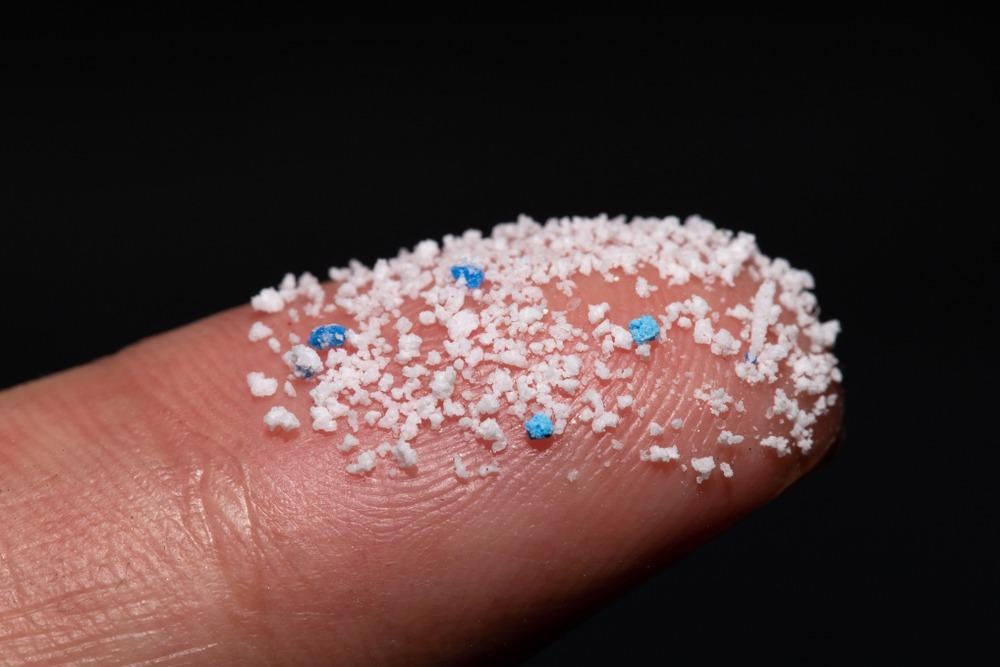Microplastic particles have come under scrutiny in the last few years due to the significant damage they cause to the environment – despite their diminutive size. Scientists recently demonstrated intelligent self-propelling nanorobots that can swim, attach to plastics, and break them down in the environment.

Image Credit: David Pereiras/Shutterstock.com
The nanorobots were presented in a paper in ACS Applied Materials & Interfaces. This research builds on the low-energy approaches to microplastics removal already in circulation, adding intelligent nanorobots to make an autonomous microplastic removal technique.
Sunlight-activated catalysts have been known to be effective at breaking down microplastics for some time. The benefits of this biomimetic chemical technique are its low energy and labor requirements.
But, until now, a reliable and similarly low-energy, low-labor method for introducing the catalyzing material to microplastics already polluting our environment had not been discovered.
The tiny robots developed by researchers are sunlight-activated as well, as sunlight propels them towards microplastic particles in water, where they then attach and bond with the plastic material.
Then, sunlight catalyzes a chemical reaction in the bonded nanorobot and microplastic particle, ultimately degrading the microplastic down into its constituent (and non-toxic) molecular parts.
The main benefit of this approach, say researchers, is its ability to reach extreme and isolated sites. Microplastics have been found on top of the Alps and at the bottom of the ocean, and it is in these hard-to-reach environments that the new nanorobot technique could demonstrate its usefulness.
What Are the Problems With Microplastics?
Tiny pieces of plastic have been found pretty much everywhere on the planet. Urban environments, pristine wilderness, deep oceans, and mountain tops are all polluted by microplastic particles that will take hundreds of years to degrade on their own.
Plastic does not break down easily, but it can break up. The vast amount of plastic used in consumer products, packaging, and industrial goods today will almost certainly end life as a bunch of tiny particles scattered around the world; this is why microplastics are such a pervasive problem.
Microplastic particles can also absorb heavy metals and other pollutants, making them even more toxic to animal health when accidentally consumed through flora and water.
Photocatalytic Approaches to Removing Microplastics
Previous research has already identified a low-energy means of removing microplastics from the environment. Catalysts use sunlight to produce reactive compounds that break down the polymers making up microplastic particles.
This method is effective but limited by the challenge of getting catalyst materials to contact microplastic particles. Pretreatments or bulky mechanical stirrers have been used to demonstrate the effectiveness of the photocatalytic approach in the past, but neither of these methods is easily attempted at large scales.
A strong interaction between photocatalyst and plastic materials is necessary for the effective charge transfer in the micro- or nanoscales, but it is difficult. This difficulty combines with the typical challenges for larger-scale heterogeneous photocatalysis: low solubility, precipitation, and aggregation of the photocatalysts.
The team behind the recent ACS study intended to overcome these challenges by developing a photocatalyst that could propel itself towards microplastics using sunlight energy, then latch onto the particles and break them down.

Image Credit: chayanuphol/Shutterstock.com
Nanorobots Driven By Sunlight
The researchers transformed the catalytic material into light-driven nanorobots by making star-shaped particles of bismuth vanadate. Then, they coated the particles evenly with magnetic iron oxide.
The nanorobots were found to glom (attach) strongly to four common types of plastic and were capable of interacting with microplastic particles along their entire lengths. They could swim down a maze of channels to locate microplastic particles to latch onto.
BiVO4 was used as the photocatalytic material built into the nanorobots’ structure. Fe3O4 was the magnetic material used to create self-propulsion under sunlight and allow for the possibility of precise actuation under a magnetic field.
To test the nanorobots, the researchers lit plastics in a dilute hydrogen peroxide solution and applied the robots for seven days. The plastics lost 3% of their weight and underwent a change in their surface texture from a smooth to a pitted surface. Small molecules and components of the plastics were found in the residual solution.
The robots were effective at degrading synthetic microplastics, especially polylactic acid, and polycaprolactone. This is due to the nanoscale local self-stirring effect of catalytic materials and enhanced interaction with microplastics that did not resort to using exterior mechanical stirrers.
Nanorobots for Microplastic Removal in Extreme Sites
The authors of the study said they hoped their self-propelled nanorobot photocatalysts could be used in systems that capture and degrade microplastic particles in hard-to-reach locations.
Recently, an extremely high quantity of microplastic particles was identified in some of the most untouched areas of wilderness on Earth, including the top of the Alps in Europe and on the almost unpopulated continent of Antarctica.
The hybrid wireless abilities of the nanorobots make them ideally suited for working autonomously in harsh environments. However, drastically reducing our reliance on plastic for packaging and goods is required to effectively tackle the microplastic problem for the future.
What are the Benefits of Microbots?
References and Further Reading
American Chemical Society (2021) Bacteria-sized robots take on microplastics and win by breaking them down. [online] ScienceDaily. Available at: https://www.sciencedaily.com/releases/2021/06/210610135744.htm
Beladi-Mousavi, S. M., S. Hermanová, Y. Ying, J. Plutnar, and M. Pumera (2021) A Maze in Plastic Wastes: Autonomous Motile Photocatalytic Microrobots against Microplastics. ACS Applied Materials & Interfaces. Available at: https://doi.org/10.1021/acsami.1c04559
Disclaimer: The views expressed here are those of the author expressed in their private capacity and do not necessarily represent the views of AZoM.com Limited T/A AZoNetwork the owner and operator of this website. This disclaimer forms part of the Terms and conditions of use of this website.